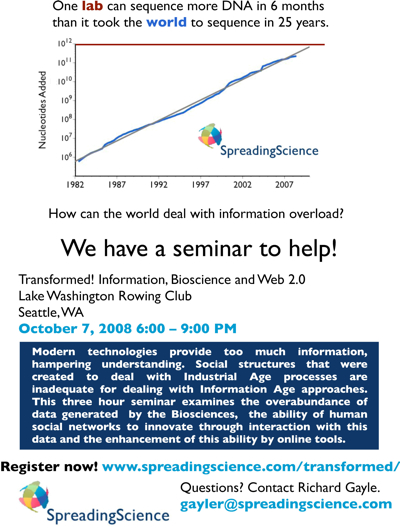 by txd
by txd
Attention, science and money:
[Via business|bytes|genes|molecules]
Interesting observation by Kevin Kelly. He says
Where ever attention flows, money will follow
To some extent, that’s somewhat obvious. Peter Drucker, whom I admire a lot, said the following
Marketing and innovation produce results; all the rest are costs
Part of the problem with many corporations that commercialize science and technology is that they only focus on the marketing and not the innovation. I remember being told by a higher up that marketing made money – For every dollar we spend on Marketing, we get $3 back. But he told me that research cost money, money that was never directly recouped.
There are good metrics for marketing, not so much for innovation. Yet without the latter the former has nothing to do.
Attention can be driven by many mechanisms, marketing being the most effective one. The key is gaining sufficient mindshare, which is often accompanies by a flow of capital. In science, the money follows topics of research that have mindshare. Similarly people fund companies in areas that generate mindshare for whatever reason.
The question I often ask myself, both from my time as a marketer and as someone interested in science communication, is how can we bring more mindshare to some of our efforts and science in general. What does money flow mean? Is it just research funding? Is it investment in such concepts as “bursty work”? Take something else Kelly writes
New things that don’t work or serve no purpose are quickly weeded out of the system. But the fact that something does work or is helpful is no longer sufficient for success.
Part of the problem is that many researchers feel the data should speak for itself. They fail to realize that gaining mindshare or convincing people requires social interactions. It is a very rare thing that requires no further work in order to sell itself.
We all realize that nothing in science is this way. That is, when we deal with each other, we realize that further experimentation is required to convince us of a new innovation. Few things just emerge from Zeus’ head. we know the process to market to our peers – publications, conferences and seminars.
But the idea of doing something similar to get innovations out to non-scientists is not on an researcher’s radar screen. We don’t have enough time for that. Perhaps just a recognition that there is a process people go through to adopt an innovation and the attempt to facilitate some of those steps would go a long way.
I have written about the lack of marketing in science (stealing shamelessly from Larry Page). It’s critical that we do a better job of highlighting the power of our activities and learn some marketing tricks along the way. No I am not talking about the in your face stuff that gives marketing a bad name, but about the kinds of activities that maintain that attention, and get people to notice. The good news, many of us already do that, perhaps without even realizing it. It’s still niche awareness, but I have a feeling that we are close to actually crossing the hump and bringing some of our activities into the mainstream.
KK link via Michael Nielsen
Marketing is really just convincing people to make a change in their life, to adopt an innovation. It may have a bad odor in science (because ads make people want things that they do not really need) but marketing is really what everyone does who truly wants to compete for mindshare.
We just need to do it in a way that supports research while helping others through the process of adopting innovations.








